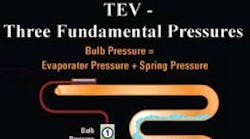By Dave Demma
Knowing that the TEV (TXV) is a superheat control eliminates wasteful speculation and wild goose chases regarding its operation. Simply measure the superheat to reveal whether it’s functioning correctly. If it’s too high, it has to be the result of the valve underfeeding. If too low, it may either be the result of overfeeding, or other some other condition that’s unrelated to the TEV.
Understanding the forces which determine the TEV operation makes it easy to logically prepare a list of potential causes for underfeeding/overfeeding symptoms. However, not all superheat abnormalities are the result of TEV failure. Keep in mind that the evaporator is a heat transfer device, and rated airflow is required for the evaporator to operated at its rated capacity. If the airflow is restricted (dirty evaporator, incorrect motor/ fan, frost, etc.) the TEV now becomes too large for the reduced heat transfer ability of the evaporator. This can be the cause of overfeeding.
High superheat is the result of insufficient refrigerant flow in comparison to the load requirement. Possibilities: TEV too small, superheat adjustment incorrect, external equalizer plugged up (remember the pushrod leakage would prove vital. When the equalizer is plugged up, the small amount of leakage will accumulate under the diaphragm, with no means of venting. The pressure will approach the liquid pressure, causing the closing force to overpower the opening force, closing the valve), trash in the TEV port restricting refrigerant flow, contaminant in the TEV body preventing the pin from moving (opening), insufficient liquid feed to the TEV inlet (plugged strainer or filter-drier, flash gas in the liquid supply).
Again following the example of a doctor, when a component is replaced due to failure, it should be given an autopsy. Disassembly will reveal the cause of failure, and can then be used as a basis for corrective action.
The technician should approach troubleshooting in the same manner that a doctor approaches diagnosing illness: a logical process based upon a solid foundation of understanding the function and operation of the components and the system.
Dave Demma is supermarket sales manager of the Sporlan Valve Division of Parker Hannifin. He can be reached at 636/239-1111. Diagrams courtesy Sporlan.











